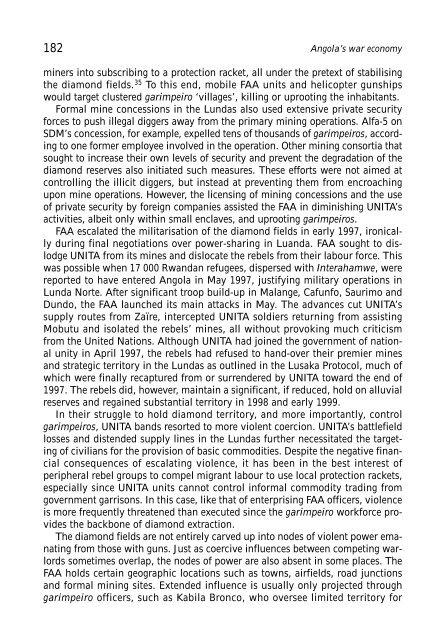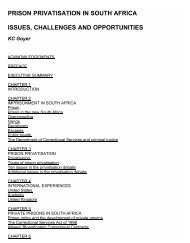Power struggles in the diamond fields - Institute for Security Studies
Power struggles in the diamond fields - Institute for Security Studies
Power struggles in the diamond fields - Institute for Security Studies
You also want an ePaper? Increase the reach of your titles
YUMPU automatically turns print PDFs into web optimized ePapers that Google loves.
182 Angola’s war economy<br />
m<strong>in</strong>ers <strong>in</strong>to subscrib<strong>in</strong>g to a protection racket, all under <strong>the</strong> pretext of stabilis<strong>in</strong>g<br />
<strong>the</strong> <strong>diamond</strong> <strong>fields</strong>. 35 To this end, mobile FAA units and helicopter gunships<br />
would target clustered garimpeiro ‘villages’, kill<strong>in</strong>g or uproot<strong>in</strong>g <strong>the</strong> <strong>in</strong>habitants.<br />
Formal m<strong>in</strong>e concessions <strong>in</strong> <strong>the</strong> Lundas also used extensive private security<br />
<strong>for</strong>ces to push illegal diggers away from <strong>the</strong> primary m<strong>in</strong><strong>in</strong>g operations. Alfa-5 on<br />
SDM’s concession, <strong>for</strong> example, expelled tens of thousands of garimpeiros, accord<strong>in</strong>g<br />
to one <strong>for</strong>mer employee <strong>in</strong>volved <strong>in</strong> <strong>the</strong> operation. O<strong>the</strong>r m<strong>in</strong><strong>in</strong>g consortia that<br />
sought to <strong>in</strong>crease <strong>the</strong>ir own levels of security and prevent <strong>the</strong> degradation of <strong>the</strong><br />
<strong>diamond</strong> reserves also <strong>in</strong>itiated such measures. These ef<strong>for</strong>ts were not aimed at<br />
controll<strong>in</strong>g <strong>the</strong> illicit diggers, but <strong>in</strong>stead at prevent<strong>in</strong>g <strong>the</strong>m from encroach<strong>in</strong>g<br />
upon m<strong>in</strong>e operations. However, <strong>the</strong> licens<strong>in</strong>g of m<strong>in</strong><strong>in</strong>g concessions and <strong>the</strong> use<br />
of private security by <strong>for</strong>eign companies assisted <strong>the</strong> FAA <strong>in</strong> dim<strong>in</strong>ish<strong>in</strong>g UNITA’s<br />
activities, albeit only with<strong>in</strong> small enclaves, and uproot<strong>in</strong>g garimpeiros.<br />
FAA escalated <strong>the</strong> militarisation of <strong>the</strong> <strong>diamond</strong> <strong>fields</strong> <strong>in</strong> early 1997, ironically<br />
dur<strong>in</strong>g f<strong>in</strong>al negotiations over power-shar<strong>in</strong>g <strong>in</strong> Luanda. FAA sought to dislodge<br />
UNITA from its m<strong>in</strong>es and dislocate <strong>the</strong> rebels from <strong>the</strong>ir labour <strong>for</strong>ce. This<br />
was possible when 17 000 Rwandan refugees, dispersed with Interahamwe, were<br />
reported to have entered Angola <strong>in</strong> May 1997, justify<strong>in</strong>g military operations <strong>in</strong><br />
Lunda Norte. After significant troop build-up <strong>in</strong> Malange, Cafunfo, Saurimo and<br />
Dundo, <strong>the</strong> FAA launched its ma<strong>in</strong> attacks <strong>in</strong> May. The advances cut UNITA’s<br />
supply routes from Zaïre, <strong>in</strong>tercepted UNITA soldiers return<strong>in</strong>g from assist<strong>in</strong>g<br />
Mobutu and isolated <strong>the</strong> rebels’ m<strong>in</strong>es, all without provok<strong>in</strong>g much criticism<br />
from <strong>the</strong> United Nations. Although UNITA had jo<strong>in</strong>ed <strong>the</strong> government of national<br />
unity <strong>in</strong> April 1997, <strong>the</strong> rebels had refused to hand-over <strong>the</strong>ir premier m<strong>in</strong>es<br />
and strategic territory <strong>in</strong> <strong>the</strong> Lundas as outl<strong>in</strong>ed <strong>in</strong> <strong>the</strong> Lusaka Protocol, much of<br />
which were f<strong>in</strong>ally recaptured from or surrendered by UNITA toward <strong>the</strong> end of<br />
1997. The rebels did, however, ma<strong>in</strong>ta<strong>in</strong> a significant, if reduced, hold on alluvial<br />
reserves and rega<strong>in</strong>ed substantial territory <strong>in</strong> 1998 and early 1999.<br />
In <strong>the</strong>ir struggle to hold <strong>diamond</strong> territory, and more importantly, control<br />
garimpeiros, UNITA bands resorted to more violent coercion. UNITA’s battlefield<br />
losses and distended supply l<strong>in</strong>es <strong>in</strong> <strong>the</strong> Lundas fur<strong>the</strong>r necessitated <strong>the</strong> target<strong>in</strong>g<br />
of civilians <strong>for</strong> <strong>the</strong> provision of basic commodities. Despite <strong>the</strong> negative f<strong>in</strong>ancial<br />
consequences of escalat<strong>in</strong>g violence, it has been <strong>in</strong> <strong>the</strong> best <strong>in</strong>terest of<br />
peripheral rebel groups to compel migrant labour to use local protection rackets,<br />
especially s<strong>in</strong>ce UNITA units cannot control <strong>in</strong><strong>for</strong>mal commodity trad<strong>in</strong>g from<br />
government garrisons. In this case, like that of enterpris<strong>in</strong>g FAA officers, violence<br />
is more frequently threatened than executed s<strong>in</strong>ce <strong>the</strong> garimpeiro work<strong>for</strong>ce provides<br />
<strong>the</strong> backbone of <strong>diamond</strong> extraction.<br />
The <strong>diamond</strong> <strong>fields</strong> are not entirely carved up <strong>in</strong>to nodes of violent power emanat<strong>in</strong>g<br />
from those with guns. Just as coercive <strong>in</strong>fluences between compet<strong>in</strong>g warlords<br />
sometimes overlap, <strong>the</strong> nodes of power are also absent <strong>in</strong> some places. The<br />
FAA holds certa<strong>in</strong> geographic locations such as towns, air<strong>fields</strong>, road junctions<br />
and <strong>for</strong>mal m<strong>in</strong><strong>in</strong>g sites. Extended <strong>in</strong>fluence is usually only projected through<br />
garimpeiro officers, such as Kabila Bronco, who oversee limited territory <strong>for</strong>
















